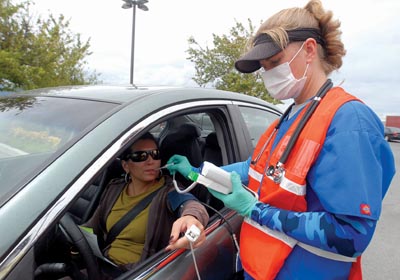
Hazel Hawkins Memorial Hospital has held many emergency planning
drills in the past, but for the first time its staff this week
experienced what might occur in a major pandemic scenario involving
the use of a parking lot to prevent contamination inside the
building.
Hazel Hawkins Memorial Hospital has held many emergency planning drills in the past, but for the first time its staff this week experienced what might occur in a major pandemic scenario involving the use of a parking lot to prevent contamination inside the building.
The local hospital Tuesday morning coordinated a “drive-through” drill in a campus lot in which staff members acted out a response to the theoretical flu pandemic. It involved an array of stations with tents, and hospital staff members volunteered to act as the patients with virus symptoms.
They drove from stop to stop, as directed by the medical staff, and were kept inside their vehicles as part of the drill’s focus on prevention. The last station was an observation tent that included cots and blankets for patients.
The training helped doctors, nurses and other personnel get a better feel for a pandemic scenario, one that calls for the use of outdoor space to prevent further contamination inside the hospital, said Frankie Arballo, Hazel Hawkins’ head of marketing and public relations. But it also served as a chance for the hospital to test its resources.
Emergency Room Director Rebecca Jones explained that the hospital had been planning the drill for six months. Stanford Hospital performed it last fall, and a few weeks later Hazel Hawkins staff leaders went there and learned details about the exercise, she said.
From the drill Tuesday, Jones noted how the staff learned it needs more resources for such a pandemic event. She pointed out how they realized they could use one more doctor and that it might be better to offer two driving lanes instead of one.
Jones, the drill’s incident commander, also said the staff in the training exercise had the added benefit of usually having to serve just one patient, or vehicle, at a time.
“In reality, there could be five, or six, or eight cars in line,” said Jones, adding how the hospital received a grant to buy the supplies.
That supplies and equipment were laid out in the parking lot in an organized maze directing patients to the next appropriate stop after each station.
See the full story in the Pinnacle on Friday.









